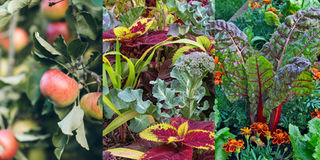Improve your garden’s aesthetic with ornamentals and edibles

What you need to know:
The purpose of combining your plants is to improve your garden’s aesthetics. It also enables you make use of your space.
Nowadays it is possible to not only grow edibles anywhere, but to also do it in a way that makes it part of your living landscape. With space becoming more precious, it now makes sense to have an eclectic mixing of edibles and ornamental plants sharing the same lot. This is such a delicious way to change your garden style.
Why combine
In addition to allowing for maximum use of space, growing specific plants together is mutually benefitial for them. When planted together plants become a practical way to combat pests and diseases, attract pollinators and beneficial insects and also helps with nutrient uptake. It is also a healthy way of limiting the use of insecticides. Ornamentals tend to attract pollinators, which may lead to higher yields of fruits and fruiting vegetables.
Edible gardening tends to lack the necessary drama attractive to the eye. By adding ornamental plants, you are able to enhance the beauty of the landscape and create year-round interest.
Considerations
To successfully embark on your combined garden, you need to understand a few gardening and design practicalities, such as:
Garden orientation
Vegetables, herbs and fruiting plants require specific conditions to grow. For instance most edibles prefer full sun while ornamentals can survive on at least half a day of full sun. This means the best place for ornamentals is a shady spot which will not support most edibles.
Similarly, many leafy vegetables require regular watering, yet some herbs, especially the Mediterranean one prefer to not be watered regularly. Another thing you need to take into consideration is the type of soil you have and figure out what plants can successfully grow in it.
Pest control
Since it is important not to use pesticides in our vegetable gardens, you need to consider how you will handle pest control. Edible plants are more likely to be affected by pests and diseases than ornamental plants.
To control pests and diseases without resorting to artificial pesticides, requires the gardener to use organic products or homemade ‘friendly’ sprays, planting pest susceptible plants with appropriate protective companion plants or introducing plants that attract beneficial insects to help with controlling pests on the edibles.
Accessibility
When combining edibles with ornamental, keep in mind that the former need to be regularly harvested. So plant the edibles depending on how regularly you will be harvesting them. The perfect place to plant edibles in on the garden edges.
Aesthetics
The purpose of combining your plants is to improve your garden’s aesthetics. In order to get your edibles to complement your ornamentals consider how their mature size, shape, texture and colours of leaves, stems, branches, flowers and fruits before choosing what to add to your garden.
Unlike ornamentals, many edibles do not grow neat and tidy, if anything, plants such as tomatoes, cucumbers, squash and runner or pole beans take up too much space and grow all over the place. This will make combine gardening a bit tricky because the garden will look too cluttered and might even chock up some ornamentals.
To solve this challenge, experts recommend growing such plants on trellises and other frameworks to keep them neat and tidy and allow for enough space.
Which plants
Combine neat and tidy leafy veggies such as lettuces, baby spinach and larger growing spinach, cabbages and herbs such as sweet basil, purple basil and parsley and chives which have neat growth patterns.
For a strong colour pop to your ornamental garden, consider artichokes, lavenders, dinosaur/curly kale, sage and catmint. Artichokes also add texture to the garden as they have interesting sword shaped leaves and lovely large thistle like pink or purple flowers. Lavenders are obviously lovely bloomers and catmint produces masses of purple flower spikes. Dinosaur or curly kale has lovely blue grey curly foliage which adds texture to the garden.
Herbs such as pineapple sage, lavenders, rosemary, tansy, yarrow, beebalm, catmint, borage, anise hyssop, lemon verbena and chives, will add great flower colour to your garden.
All fruiting plants add colour to an ornamental garden so consider adding eggplants, tomatoes, chillies and peppers, strawberries, blueberries etc., to your garden.
Companion plants
Companion growing is an effectively organic way to control pests and diseases by growing plants that are beneficial to each other. These are some ornamentals and herbs that will aid your edible garden, whether by protecting the plant or helping with the uptake of nutrients.
- Petunias deter bean beetles when planted with beans.
- Calendula should be planted with Brassicas as they exude a sticky substance that attracts aphids, and they get stuck. The flowers also attract ladybirds, which will then eat the aphids.
- Asters deter most insects.
- Borage is said to deter worms, so plant them near tomatoes and cabbages.
- Catnip deters flea beetles, Japanese beetles and weevils.
- Chrysanthemums deter most insects as they have a strong smell but also work for soil nematodes and are said to be useful for red spider mites as well.
- Geraniums deter most insects because of the strong oils they exude.
- Marigolds are very well known for killing soil nematodes but are also useful for deterring bean beetles, squash bugs, thrips and whiteflies.
- Peppers and tomatoes do well when planted with marigolds.
- Rosemary is an ornamental herb and is useful for preventing cabbage moth, bean beetle and carrot fly.
- Lavender is an ornamental herb that keeps away cabbage moths.
- Nasturtiums trap aphids as well as deter squash bugs and beetles.




